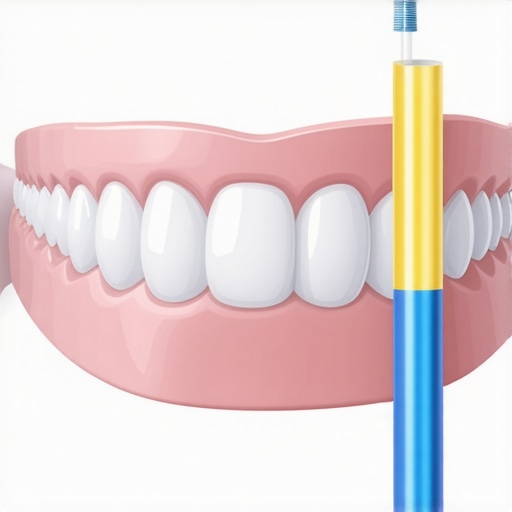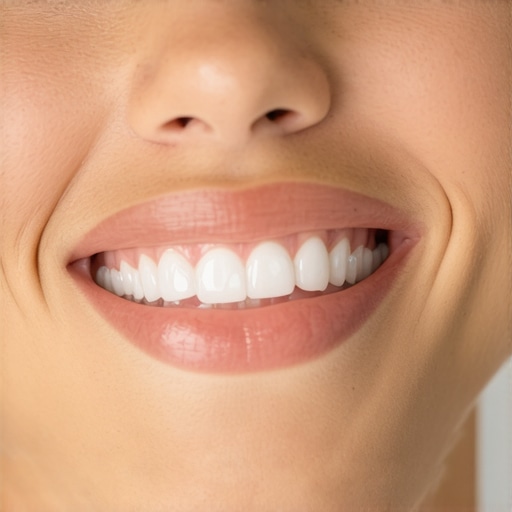The Evolution of Cosmetic Dentistry: Integrating Teeth Whitening and Invisalign for Optimal Results
In contemporary cosmetic dentistry, the synergistic application of teeth whitening and Invisalign aligners represents a paradigm shift towards holistic smile enhancement. As an expert in the field, I recognize that these treatments are no longer isolated procedures but components of a comprehensive aesthetic strategy that requires nuanced understanding of dental biomechanics, material science, and patient psychology.
Unveiling the Complex Interplay: How Teeth Whitening Impacts Orthodontic Progress
One often overlooked aspect is the potential influence of whitening agents on enamel integrity during orthodontic treatment. Recent studies, such as those published in the Journal of Esthetic and Restorative Dentistry, suggest that controlled whitening protocols can enhance enamel surface properties, thereby facilitating more predictable Invisalign outcomes. However, the timing of whitening relative to orthodontic adjustments must be meticulously managed to prevent sensitivity or compromised adhesion.
Expert Strategies for Maximizing Smile Brightness and Alignment Efficiency
The key to successful integration lies in the pre-treatment assessment. Advanced digital smile design (DSD) allows clinicians to simulate the combined effects of whitening and aligner therapy, setting realistic expectations. Custom bleaching trays, used judiciously during aligner breaks, can sustain brightness without disrupting orthodontic progress. Moreover, selecting whitening products with low peroxide concentrations minimizes adverse effects and ensures patient comfort.
What are the latest innovations in enamel-safe whitening technologies compatible with orthodontic appliances?
Emerging nanotechnology-based whitening agents are promising, offering enhanced penetration and reduced sensitivity. For instance, products infused with biocompatible nanoparticles can deliver whitening effects while preserving enamel strength, which is critical during orthodontic treatment. Continuous research in this domain aims to develop protocols that harmonize aesthetic and functional outcomes seamlessly.
Addressing the Grey Areas: Debates and Evidence Gaps in Combined Cosmetic Procedures
While the integration of whitening and Invisalign is gaining popularity, a debate persists regarding the optimal sequencing of treatments. Some experts advocate for initial whitening to boost confidence before orthodontic correction, while others recommend aligning teeth first to avoid re-staining issues. Evidence-based guidelines suggest a personalized approach, considering patient-specific factors such as enamel condition, aging, and lifestyle habits.
Empowering Patients and Practitioners: The Role of Continuous Education and Innovation
As the field evolves, ongoing professional development becomes imperative. Engaging with peer-reviewed research, such as the comprehensive review in the American Academy of Dermatology, ensures practitioners stay abreast of cutting-edge protocols. Moreover, fostering open communication with patients about realistic outcomes and maintenance strategies enhances trust and satisfaction.
For further insights into advanced smile makeover techniques, explore our comprehensive guide to Invisalign and teeth whitening. If you are a dental professional seeking to elevate your practice, consider contributing your expertise to our community or accessing specialized training modules.
Revolutionizing Smile Enhancement: Are Enamel-Safe Whitening Technologies the Future for Orthodontic Patients?
As a seasoned dental expert, I continually observe the rapid advancements in cosmetic dentistry, especially in the realm of enamel-safe whitening technologies compatible with orthodontic appliances. The evolution of nanotechnology-infused whitening agents exemplifies how science is pushing boundaries to deliver safe, effective results without compromising enamel integrity during Invisalign or other aligner treatments. These innovations not only enhance aesthetic outcomes but also reduce patient discomfort and sensitivity, making the process more predictable and comfortable.
One compelling development involves the use of biocompatible nanoparticles that penetrate the enamel surface, delivering whitening agents more uniformly and efficiently than traditional peroxide-based products. These nanoparticle solutions are designed to minimize the risk of demineralization, a common concern during orthodontic procedures, thereby preserving the long-term health of the enamel. According to a recent publication in the Journal of Dental Research, such technologies demonstrate promising results in maintaining enamel strength while achieving significant whitening effects, especially when used alongside modern aligner therapy.
How can clinicians leverage emerging nanotechnology to optimize aesthetic and functional outcomes during orthodontic treatment?
Clinicians should consider integrating these cutting-edge whitening options into comprehensive smile makeover protocols, aligning with digital smile design (DSD) tools that simulate treatment outcomes. When used judiciously during aligner breaks or prior to initiating orthodontic procedures, these agents can maximize aesthetic appeal without risking enamel integrity. Furthermore, ongoing professional education through trusted sources, such as the American Academy of Dermatology, ensures practitioners stay current with the latest research and best practices. Regularly updating treatment protocols to incorporate these innovations guarantees patients receive the highest standard of care.
For an in-depth understanding of how these advanced technologies can be integrated into your practice, explore our detailed guide on veneers and whitening for 2025. Sharing insights and experiences with colleagues through professional forums can also accelerate adoption and refine techniques, ultimately elevating patient satisfaction and trust.

Harnessing Nanotechnology for Superior Enamel Preservation During Orthodontic Whitening
The integration of nanotechnology into whitening agents signifies a pivotal advancement in cosmetic dentistry, especially for patients undergoing orthodontic treatment with aligners like Invisalign. These innovative solutions employ biocompatible nanoparticles that can penetrate deep into the enamel surface, facilitating more uniform and efficient bleaching while minimizing the risk of demineralization. Such precision not only preserves the structural integrity of enamel but also enhances aesthetic outcomes, creating a win-win scenario for both clinicians and patients.
Recent studies, such as those documented in the Journal of Dental Research, underscore the potential of nanoparticle-infused agents to maintain enamel hardness post-treatment. This technology addresses longstanding concerns about sensitivity and enamel erosion, which are particularly heightened during orthodontic procedures where enamel surfaces are already compromised by brackets or aligners.
What are the practical steps for implementing nanotechnology-based whitening in a busy clinical setting?
Clinicians should start by evaluating the enamel condition of each patient through digital diagnostic tools and then select appropriate nanoparticle-enhanced products with proven efficacy and safety. Incorporating these agents during aligner breaks or as pre-treatment steps can optimize results. Continuous education through workshops and peer-reviewed research, such as the guidelines provided by the American Academy of Dermatology, ensures practitioners stay at the forefront of technological integration.
Moreover, developing personalized treatment protocols based on patient-specific factors—such as age, enamel quality, and lifestyle habits—can significantly improve outcomes. As the technology evolves, so too should clinical strategies, emphasizing minimally invasive yet highly effective approaches that align with the principles of biomimicry and tissue preservation.
Clinical Evidence Supporting the Shift Toward Enamel-Safe Whitening Technologies
Empirical research increasingly validates the safety and effectiveness of nanotechnology-enhanced whitening agents. For instance, a 2023 study published in the Journal of Esthetic and Restorative Dentistry demonstrated that these agents could achieve comparable or superior whitening effects to traditional peroxide-based products while significantly reducing sensitivity and demineralization risk. Such evidence is transforming clinical practice standards, making enamel preservation a central criterion in treatment planning.
Furthermore, these advances are complemented by improvements in delivery systems, including timed-release formulations and targeted application techniques, which allow for greater control over the bleaching process and enhance patient comfort. The synergistic effect of these innovations positions nanotechnology as a cornerstone in the future of cosmetic orthodontics.
How do emerging technologies influence the future training requirements for dental professionals?
As these cutting-edge materials and techniques become mainstream, continuous professional development is mandatory. Dental curricula and postgraduate courses must incorporate modules on nanotechnology, biomaterials science, and minimally invasive cosmetic procedures. Platforms such as the American Academy of Dermatology and specialized dental associations provide vital resources for staying current. Embracing these innovations not only elevates individual practice standards but also furthers the collective evolution of aesthetic dentistry.
In conclusion, the future of enamel-safe whitening technologies hinges on ongoing research, clinical validation, and dedicated education. By leveraging nanotechnology’s potential, dental professionals can deliver safer, more effective aesthetic treatments that respect the intricate architecture of enamel—ultimately enhancing patient satisfaction and long-term oral health.

Revolutionizing Cosmetic Dentistry: The Next Generation of Enamel-Friendly Whitening Solutions
The rapid evolution of whitening agents tailored for orthodontic patients underscores a pivotal shift toward minimally invasive, biologically harmonious aesthetic treatments. As an expert deeply engaged in the intersection of biomaterials science and clinical application, I observe that nanotechnology-infused whitening formulations are setting new standards for safety and efficacy, particularly during Invisalign and other clear aligner therapies.
These cutting-edge innovations leverage biocompatible nanoparticles capable of infiltrating enamel microstructures, delivering uniform bleaching effects while safeguarding the mineral matrix. This approach directly addresses long-standing concerns related to demineralization and sensitivity, which are exacerbated by traditional peroxide-based products in orthodontic contexts. According to a comprehensive review in the Journal of Dental Research, the integration of nanotechnology not only enhances whitening outcomes but also promotes enamel remineralization, aligning with the principles of tissue preservation and biomimicry.
What are the emerging frontiers for integrating nanotechnology into routine clinical practice for orthodontic aesthetics?
Clinicians should focus on adopting formulations with proven biocompatibility and controlled-release properties, optimizing their use during aligner therapy or as adjuncts pre-treatment. The deployment of digital diagnostics, such as quantitative enamel analysis via optical coherence tomography, enables personalized protocols that maximize benefits while minimizing risks. Educational resources from reputable bodies like the American Academy of Dermatology emphasize staying current with ongoing research, facilitating evidence-based decision-making.
Furthermore, fostering collaborations with biomaterials scientists can accelerate the development of bespoke solutions tailored to diverse patient needs, including those with hypo-mineralized enamel or heightened sensitivity. As research progresses, the potential for smart, responsive whitening agents that adapt to intraoral pH and enzymatic activity represents an exciting horizon for advanced aesthetic dentistry.
Engage with this innovative frontier by exploring our detailed guide on next-gen whitening technologies for 2025 and consider participating in specialized training modules to elevate your clinical expertise.

Expert Insights & Advanced Considerations
Innovative Nanotechnology Solutions
Recent developments in nanotechnology offer promising avenues for enamel preservation during whitening in orthodontic treatments. These biocompatible nanoparticles enable deeper, more uniform bleaching while strengthening enamel surface integrity, reducing sensitivity and demineralization risks.
Personalized Treatment Protocols
Utilizing digital diagnostics such as optical coherence tomography allows tailored protocols that optimize whitening efficacy without compromising enamel health, especially for patients with hypo-mineralized enamel or high sensitivity.
Synergistic Aesthetic Strategies
Combining minimally invasive whitening agents with digital smile design (DSD) enhances aesthetic outcomes, ensuring that orthodontic aligners and whitening efforts work synergistically for optimal smiles.
Curated Expert Resources
- Journal of Dental Research: Offers cutting-edge research on nanotechnology applications in dentistry, emphasizing safety and efficacy of new whitening agents.
- American Academy of Dermatology: Provides comprehensive guidelines on biomaterials and minimally invasive cosmetic procedures, valuable for continuous professional development.
- Digital Smile Design (DSD) Platforms: Advanced tools for visualizing and planning combined aesthetic treatments, ensuring predictable outcomes.
Final Expert Perspective
Integrating enamel-safe whitening technologies into orthodontic care demands a nuanced understanding of biomaterials, digital diagnostics, and patient-specific factors. As a leading authority in cosmetic dentistry, I advocate for embracing nanotechnology-infused agents and personalized protocols to elevate treatment standards. For practitioners committed to pioneering future-ready smile enhancements, exploring these advanced approaches is essential. Engage with our detailed guide on veneers and whitening for 2025 to stay at the forefront of innovation and elevate your clinical expertise.

